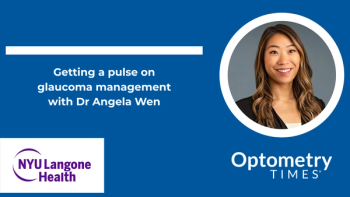
- August digital edition 2020
- Volume 12
- Issue 8
Optimizing ocular blood flow in glaucoma management
Study shows improved OBF throughout the retina with antioxidant supplementation
Glaucoma is one of the leading causes of irreversible blindness worldwide.1 The traditional understanding of glaucomatous optic neuropathy is mechanical damage to the laminar beams and retinal ganglion cell axons from increased intraocular pressure (IOP).2
However, another theory has been touted as a cause for ganglion cell loss: ocular perfusion.
Since the 2009 World Glaucoma Association’s Consensus Report on the topic, vascular factors and ocular blood flow (OBF) are gaining prominence as a major contributor to optic neuropathy.3
Low-perfusion factors
What leads to poor ocular perfusion? Increased IOP and vascular dysregulation are the main contributors: either can lead to both low perfusion pressure and insufficient autoregulation, which destabilizes ocular perfusion and creates ischemia and reperfusion damage.
Structural changes are evident in patients with low OBF and correlate well with patients who have glaucoma. For example, one study measured tissue blur rates (an indirect measurement of OBF) and found that lower blur rates are linked to increased mitochondrial deoxyribonucleic acid (DNA) damage in patients with glaucoma.4
In another study, patients with low OBF, as measured by laser flowgraphy, had a larger cup-to-disc ratio, and higher susceptibility to damage in the temporal disc and the macular area. The circumpapillary retinal nerve fiber layer thickness also decreased with low ocular perfusion.2
Due to these many variables, patients can therefore progress despite having controlled IOPs or, conversely, may not always progress when pressure is high.
Until recently, the ability to study, measure, and treat impaired OBF has been very limited. The advent of optical coherence tomographic angiography (OCTA) has made it a reality. OCTA is now widely available to help measure OBF in the clinic. Although utilization of OCTA is small among private practices due to cost, I project that adoption rates will increase rapidly over the next decade as research expands and technology becomes cheaper. For example, recent advances in OCTA (such as OptoVue’s AngioAnalytics module) now allow blood vessel density and perfusion to be quantified instead of relying on subjective assessment alone.
Problem with IOP control
In the context of traditional glaucoma management, adjusting IOP has been the mainstay of treatment. Typically, patients are started on a topical prostaglandin or laser trabeculoplasty for first-line therapy.5 Further topical medications are added stepwise to achieve a goal of 30 to 40 percent decrease in IOP. If the patient continues to progress and her targeted IOP is at its goal, then there really are no other treatment options.
Although I am always on the lookout for patients with common risk factors for normal tension glaucoma (NTG)—including female gender, low body mass index, autoimmune disease, and Raynaud’s phenomenon—almost all of these risk factors are uncontrollable. I often advise everyone to increase their cardiovascular exercise and eat a diet high in antioxidants, but this can be difficult for some patients. Multiple antihypertensive medications may be partly to blame for low perfusion, but often patients cannot come off them. Many clinicians are now turning to adjunctive strategies to alter ocular perfusion, including antioxidant formulations.
Antioxidants and OBF
One adjunctive strategy with a low side-effect profile is oral antioxidants. A recent study included a dietary supplement, Optic Nerve Formula (ONF; ScienceBased Health), composed of essential vitamins and minerals, antioxidants, gingko biloba, polyphenols, and bilberry extracts.6 Many of these ingredients have been found to support OBF.
In this prospective, randomized, crossover clinical study, 42 patients with open-angle glaucoma were evaluated for the effects of a novel antioxidant formula.7 Approximately 20 percent of these patients were deemed of the normotensive subtype. This study looked at the effects of ONF specifically on OBF velocity, resistance, and perfusion. Although previous studies have been performed on this topic, they have been observational to date. Using ultrasound and laser Doppler imaging, ocular perfusion pressure (OPP), retrobulbar blood flow, and retinal capillary blood flow were non-invasively measured before and 1 month after antioxidant nutraceuticals or placebo administration.
The study concluded that ONF led to significant increases in peak systolic and/or end diastolic blood flow velocities in all retrobulbar blood vessels compared to the placebo group. Vascular resistance in the central retinal and nasal short posterior ciliary arteries were also decreased following administration. Additionally, superior and inferior temporal retinal capillary mean blood flow and the ratio of active-to-non-active retinal capillaries compared to placebo increased. There was a significant increase in: the peak systolic velocity of two of the four retrobulbar vessels; end diastolic velocity in all four retrobulbar vessels; and superior and inferior mean capillary blood flow.
In addition, comparison of baseline to post-administration measurements in the antioxidant arm revealed a significant decrease in vascular resistance and a reduction in the amount of dormant retinal capillaries in the superior and inferior temporal regions. These findings paint a consistent picture, using several methods, that OBF throughout the retina is better optimized with antioxidant supplementation.
Several points from this study are worth mentioning. There were no adverse events reported with this supplement during the study and no changes in either IOP or blood pressure. Although IOP reduction remains the only approved method to treat glaucoma, clinicians should consider ONF as an adjunct. Given the increased recognition of the role of OBF in glaucoma, these findings are noteworthy. Since progression can occur even when IOP is not elevated, methods of supporting blood flow show promise for the future.
Additional benefits
Supplements and dietary nutrients also cover other areas besides OBF. Antioxidants such as those used in the Harris et al study7 can combat oxidative stress, counter toxic compounds, and support mitochondrial function, which is thought to play a role in the death of retinal ganglion and trabecular meshwork cells.
Supplements offer patients something they can do proactively. Those with controlled or normal pressures who are still progressing will be grateful to have something else they can try in addition to current therapies. However, decreased OBF has been linked with glaucoma generally, and all patients, even early-stage or glaucoma suspects, may benefit.
Conclusion
The way clinicians treat and manage open-angle glaucoma is dependent on both patient and clinician. Topical therapies, lasers and microinvasive surgeries continue to be the mainstays of treatment. Early use of supplements can be viewed as adjuncts to these treatments. Each patient requires a tailored treatment strategy, in which supplements can play a role. Supporting OBF, optic nerve function, and overall ocular health are valuable components to excellent vision and should be the primary focus of every clinician as they see and manage patients.
References
1.Quigley HA, Broman AT. The number of people with glaucoma worldwide in 2010 and 2020. Br J Ophthalmol. 2006;90:262-267.
2. Flammer J, Orgül S, Costa VP, Orzalesi N, Krieglstein GK, Serra LM, Renard J-P, Stefánsson E. The impact of ocular blood flow in glaucoma. Prog Retin Eye Res. 2002;21(4):359-393.
3. Weinreb RN, Harris A. World Glaucoma Association 6th Consensus Meeting: Ocular Blood Flow in Glaucoma. Fort Lauderdale, FL, May 2, 2009. Kugler Publications.
4. Inoue-Yanagimachi M, Himori N, Sato K, Kokubun T, Asano T, Shiga Y, Tsuda S, Kunikata H, Nakazawa T. Association between mitochondrial DNA damage and ocular blood flow in patients with glaucoma. Br J Ophthalmol. 2019;103:1060-1065.
5. Himori N, Kunikata H, Shiga Y, Omodaka K, Maruyama K, Takahashi H, Nakawaza T. The association between systemic oxidative stress and ocular blood flow in patients with normal-tension glaucoma. Graefes Arch Clin Exp Ophthalmol. 2016 Feb;254(2):333-341.
6. Gazzard G, Konstantakopoulou E, Garway-Heath D, Garg A, Vickerstaff V, Hunter R, Gareth Ambler 5, Bunce C, Wormald R, Nathwani N, Barton K, Rubin G, Buszewicz M, LiGHT Trial Study Group. Selective laser trabeculoplasty versus eye drops for first-line treatment of ocular hypertension and glaucoma (LiGHT): a multicentre randomised controlled trial. Lancet. 2019 Apr 13;393 (10180):1505-1516.
7. Harris A, Gross J, Moore N, Do T, Huang A, Gama W, Siesky B. The effects of antioxidants on ocular blood flow in patients with glaucoma. Acta Ophthalmol. 2018 Mar;96(2);e237-e241.
Articles in this issue
over 5 years ago
3 steps to managing scleral lens patients with allergiesover 5 years ago
3 reasons to fit kids with contact lensesover 5 years ago
Dry eye intranasal spray stimulates the trigeminal nervesover 5 years ago
Technology for optometry post COVID-19over 5 years ago
5 essential truths to treating dry eye diseaseover 5 years ago
How the tear film affects IOL measurementsover 5 years ago
The evolving standard of care in AMDover 5 years ago
The time is now for optometry and telehealthover 5 years ago
IPL: The science of comfort and safetyNewsletter
Want more insights like this? Subscribe to Optometry Times and get clinical pearls and practice tips delivered straight to your inbox.



















































.png)


